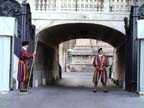










Page 13 |
|
| St. Peter's Catacombs | |
| St. Peter was crucified head down in the summer of 64 AD. His death came at the orders of Nero after a terrible fire burned down most of Rome that summer. Nero had numerous Christians "accused of hate toward humankind" and condemned to death in the circus (a round sporting arena lined with seats). I guess he held the Christians responsible for the fire. With permission from the imperial authorities, the body of Peter was removed from the cross and buried by the Christian community in naked earth not far from the circus, beyond the imperial possessions. This area of the Vatican was later occupied by tombs of various types and importance, mainly pagan burials, but also Christian. Fifty years after Peter's death the first of the mausoleums were constructed in the necropolis (city of the dead). The mausoleums (a building housing a tomb or tombs) were meant to hold a lot of bodies, (~120-170 on average.) With the twenty-two mausoleums discovered that means around 1,000 people were buried there. In some cases there are more than one family name over the door, so some mausoleums were shared by multiple families. These buildings had rooms about 20 x 20 feet with roofs, where the families would come and party in honor of their past relatives. There are even holes in the floor where they would pour in wine for the deceased to enjoy. The Vatican necropolis only saw daylight for about 200 years before it was buried. This happened because in 318 AD Constantine ordered a basilica to be built on the same land. This was called the Constantinian Basilica. (On April 18, 1506 the building of the current St. Peter's Basilica was started. More about that later.) In the process of building the new basilica Constantine ordered the site to be leveled which destroyed many mausoleums of Romans and Greeks on the highest land. Some of the roofs of other mausoleums were removed, and those on lower ground were left intact, but they all were buried under clean earth. The clean earth turned out to be the best thing for preserving the mausoleums. The workers were very respectful of the mausoleums and inscriptions, sarcophaguses (a stone coffin) and urns were almost always left in place or only moved to prevent their being damaged during construction. Constantine also ordered St. Peter's tomb to be encased in a 9 foot high marble box to protect it from any further graffiti or vandalism. |
|
| Pope Pius XII Pacelli ordered the start of the excavation for St. Peter's tomb in 1939 and it ended in the 1950's. St. Peter was buried in 64 AD in a very small grave with a 4 foot altar that stands directly above it. The existence and location of the altar and tomb was known because of a letter written in 1032 AD which Pope Pius XII Pacelli read and the Vatican currently has possession of. On December 23, in the Holy Year of 1950 Pope Pius XII announced to the world that the excavations had rediscovered the tomb of St. Peter. The tomb rests in what is now known as the catacombs and has the main basilica on top of it. In excavating the tomb they had to dig up from below the tomb in order to get under the marble encasement surrounding it. The Pope's altar that is located under the center of the cupola of the current basilica, is directly over the tomb of St. Peter. This made the excavation very hard as they didn't want to destroy the integrity of the altar. Which is why they had to excavate from the bottom of the tomb instead of the top, as modern scientific methods dictated. When they reached the tomb from below, they found it empty of St. Peter's remains. They later found what is believed to be his remains on the back of the outside wall of the 4 foot high altar directly above the tomb. There was a simple inscription that read "Here lies St. Peter". It is believed that both St. Peter and St. Paul's remains were removed from their respective tombs and kept in two or three other churches until they were returned to their original sites sometime later. The reason for the bodies being moved originally is not clear. When entering the catacombs below the Cathedral you can immediately feel the 90% humidity which is required to keep the integrity of the foundation of the whole Cathedral. If it drops below 90% the bricks will dry out and crumble. Each section of the catacombs has humidity controlled glass doors and the mausoleums are sealed with windows (for viewing the separate rooms and crypts), which keeps the environment free of harmful bacteria. The lighting system also has filters to prevent the growth of micro-organisms. |
|
| Because of all the environmental recovery and restoration work, no pictures of any kind were allowed. In fact, large purses and backpacks were not allowed because of the narrow spaces, they were taking no chances of anybody or anything touching the walls. |
|
 |
Getting into the Catacombs was an adventure! First you need to walk up to the Swiss Guards on the left side of the Vatican. This makes all the other tourist feel that you are special. Then you ask for permission to go to the excavation office. Once that is granted and you walk back to the office. Now all the other tourist really know that you are special! Once in the office you tell the man how many people and what language and he will tell you what day you can come back. It usually takes about one week. This is all word of mouth because they only allow in 120 people per day, so there's no need to advertize the catacombs. If you do visit Rome you want to see the catacombs when you visit the Vatican. You can send an email request to [email protected] or fax to 011 39 06 698 73017. Send your request as soon as you know your dates and then plan your trip around the date of your catacomb tour, you will be glad you did! |
| This is a very short description of the catacombs. Sharon and I were there for about 2 hours and were learning something new every minute. In the excavation office they sell a book called The Vatican Necropolis for a whopping 6.50 Euro. It is very informative and has lots of pictures. Even if you don't get to go on the tour you want the book. The only place it is sold is in the excavation office so you must go past the Swiss Guards. P.S. Women must have on shirts with sleeves or a shawl, plus a skirt to the knee or capri pants or slacks. Men must have on shirts with sleeves and long pants. You will not get in if you don't. You cannot even go to the excavation office to make reservations if you are not properly dressed. The Vatican has the same dress code. |
|
Website Copyright ©2003 All rights reserved. Peggy Glenn